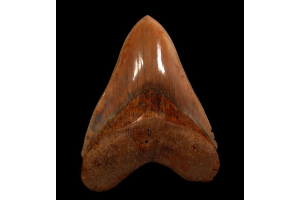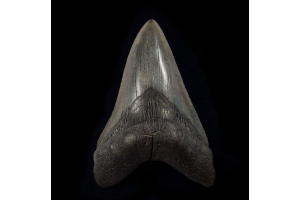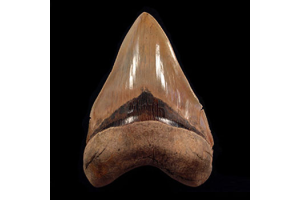Page 3 - Home Page Latest Post
- - December 04, 2025
Long before humans explored the deep blue sea, there lived a shark so gigantic that its bite could crush a whale in half. Its legend still roars through the oceans of imagination today. Kids can’t get enough of stories about this ancient predator—and the mystery that lies inside a big megalodon tooth! These colossal fossils spark wonder, adventure, and curiosity, reminding young explorers that even the ocean once had a king like no other.
The Ocean’s Biggest Predator: Meet the Megalodon
Picture a shark longer than a school bus—nearly 60 feet of pure power gliding through prehistoric seas. The Megalodon wasn’t just any shark; it was the ultimate ocean giant, ruling the waters from around 20 million to 3 million years ago. Its name, Carcharocles megalodon, literally means “big tooth,” and for good reason. Its teeth could reach over seven inches long—about the size of an adult’s hand!
Scientists believe the Megalodon hunted huge marine animals such as whales, dolphins, and giant sea turtles.
- - December 04, 2025
At Buried Treasure Fossils, we are continuously inspired by the mysteries of prehistoric life, and few creatures captivate the imagination as much as the Megalodon shark. Once the apex predator of the oceans, this extinct giant is revered today for the massive fossilized teeth it left behind. These fossils serve as timeless treasures for collectors, educators, and fossil enthusiasts around the world. Whether you're just beginning your fossil journey or you've been fascinated by these ancient remains for years, adding Megalodon teeth in Florida to your collection offers a unique glimpse into a time when giants ruled the seas.
The awe-inspiring size of Megalodon teeth, which can reach up to 7 inches in length, makes them among the largest fossilized teeth you will ever come across. Each tooth tells a story of a massive marine predator that once patrolled the planet's oceans with power and precision. These fossils are more than just relics—they are windows into Earth's distant past and the
- - December 04, 2025
The allure of the megalodon is impossible to ignore. For fossil collectors, divers, and paleontology enthusiasts, these prehistoric sharks spark a unique fascination. While many seek out massive adult teeth as trophies, identifying a baby megalodon tooth offers a different kind of thrill. We’ve worked with countless fossil specimens and understand the curiosity around juvenile megalodon teeth. In this guide, we’ll explain what these smaller fossils look like, how to distinguish them from other shark teeth, and why they’re a worthy addition to your collection.
What is a Baby Megalodon Tooth?
A baby megalodon tooth is exactly what it sounds like: a fossilized tooth from a juvenile megalodon shark. Unlike adult teeth that can exceed 6 inches, these teeth typically measure between 0.75 and 2 inches. Their size reflects the young shark’s age, likely within its first year or two of life. Although small, these teeth are still distinct and powerful-looking, showcasing the megalodon’s characteristics
- - December 04, 2025
Buying a megalodon tooth is more than just acquiring a fossil; it’s an investment in deep time. We know that collectors, enthusiasts, and even first-time buyers often seek assurance that their purchase is the real deal. With many replicas and restored specimens in circulation, learning how to identify a genuine fossil becomes essential. Whether you’re browsing a gallery or hunting for an authentic megalodon tooth in Richmond, TX, knowing how to verify authenticity can protect you from costly mistakes.
Below is a clear guide to help you examine a tooth’s features, avoid common fakes, and buy with confidence.
Why Tooth Authenticity Really Matters
A genuine megalodon tooth holds scientific, historical, and collectible value. Authentic specimens can range from small, well-preserved fragments to massive 6-inch giants, each telling a story of a predator that once ruled prehistoric oceans.
Authenticity impacts more than just appearance. It influences value, resale potential, and your ability
- - December 04, 2025
Imagine standing by a riverbank or sandy shore, sifting through shells and pebbles when suddenly you spot something large, dark, and triangular. That moment—when your heart races with excitement—is what fossil hunters live for. If you’ve ever dreamed of finding a megalodon tooth, this guide will help you take the first thrilling step toward uncovering prehistoric treasures. At Buried Treasure Fossils, we’re passionate about making fossil discovery fun, educational, and accessible for all curious explorers.
The Ancient Giant of the Sea
Millions of years ago, long before humans roamed the Earth, the oceans were ruled by an enormous predator—the Megalodon. This prehistoric shark could grow up to 60 feet long and had teeth as big as your hand! Each of these teeth tells a story about the ocean world that existed over 3.6 million years ago. Because sharks constantly shed teeth throughout their lives, thousands of fossilized specimens remain buried beneath layers of sediment, waiting to be found.
- - December 04, 2025
Megalodon teeth have captured the imagination of fossil collectors, educators, and marine life enthusiasts for generations. At Buried Treasure Fossils, we are proud to offer a premier collection of authentic Megalodon teeth for sale, including rare specimens that exceed six inches in length. These remarkable fossils offer a direct connection to one of the most formidable predators in Earth’s history — the Megalodon shark. From the distinct heart-shaped structure to the razor-sharp serrated edges, Megalodon teeth offer an awe-inspiring glimpse into prehistoric marine life.
Let’s explore what makes these fossilized teeth so special, where they come from, and why they remain among the most sought-after treasures for fossil enthusiasts across the globe.
Here are a few aspects to consider about Megalodon shark’s jaw:
A Glimpse into Prehistoric Majesty: The Megalodon Shark
The Megalodon shark is considered the largest and most formidable shark to have ever existed. Growing up to an estimated
- - December 04, 2025
When we think about prehistoric predators, few are as jaw-dropping as the megalodon. Known as the largest shark to have ever lived, this ancient creature left behind fossils that continue to spark awe and fascination, most notably its teeth. These teeth are more than relics; they’re windows into a time when the oceans were ruled by true giants. If you're here because you're curious about how big a megalodon tooth can get, you're not alone. Many collectors, fossil enthusiasts, and educators find themselves drawn to the sheer size and striking appearance of meg teeth, which have become prized pieces in fossil collections across the world.
Understanding the Size Range of Megalodon Teeth
Megalodon teeth vary significantly in size, but they are generally large by any standard. While smaller specimens may measure around 3 inches, many reach over 5 inches in length. Teeth exceeding 6 inches are rare and highly sought after. The largest authenticated megalodon tooth ever discovered measures about
- - December 04, 2025
Collectors today face a growing challenge in acquiring one particular fossil: the Aurora megalodon tooth. Known for its sharp preservation, striking coloration, and regional rarity, this fossil once flowed into collector markets through a reliable source. That source, the Lee Creek mine near Aurora, supplied tooth specimens with unmatched characteristics. However, as access to this site has closed and collector behavior has shifted, these prized fossils have become harder to find. Understanding why this change matters helps both new and seasoned fossil hunters navigate a tightening and more competitive marketplace.
Why the Aurora Megalodon Tooth from Lee Creek Stood Out for Discovery?
The Lee Creek mine earned global recognition for the fossilized marine life it preserved beneath its phosphate-rich layers. Among the many finds, the megalodon teeth stood out for their exceptional size, high-quality enamel, and region-specific colors. Collectors could identify the origin of many teeth at
- - December 04, 2025
If you have ever wanted to own a piece of ancient history, the Otodus megalodon, So. Carolina teeth are an incredible choice. These giant shark teeth are more than just fossils; they show us the power of one of the largest predators to ever swim the oceans. In this blog, we will explore what makes these teeth from South Carolina so special, why collectors love them, and how you can be part of this exciting prehistoric story.
What Is the Otodus Megalodon?
The Otodus megalodon was a giant shark that lived millions of years ago. It could grow over 60 feet long, which is longer than a school bus. Its teeth are huge and very sharp, with some teeth measuring over seven inches. These teeth are the most common remains we have of this massive shark because its cartilage skeleton did not fossilize well.
Many of these teeth come from the coastal areas of South Carolina. They are dark gray or black, showing how they fossilized in the region’s soil over thousands of years. These teeth are highly
- - December 04, 2025
Fossil collectors often search for more than just size or shape. They want character, geological history, and something visually striking. That is where a megalodon tooth in North Carolina stands apart. One glance at its deep red or copper color and curiosity follows. Why do these teeth look different from others found across fossil-rich regions? The answer lies below the surface. Red coloration does not happen by chance. It reflects millions of years of chemical processes, Earth's geological history, and a unique environment. Let us explore why these fossils carry such an eye-catching hue.
Red Coloration Begins in the Ground
Soil chemistry plays a significant role in the transformation of fossils over time. North Carolina offers a unique blend of sediment, water movement, and mineral composition. The ground here contains a higher concentration of iron compared to other regions. When a megalodon tooth rests buried in this iron-rich environment, it absorbs that element gradually. Over thousands







